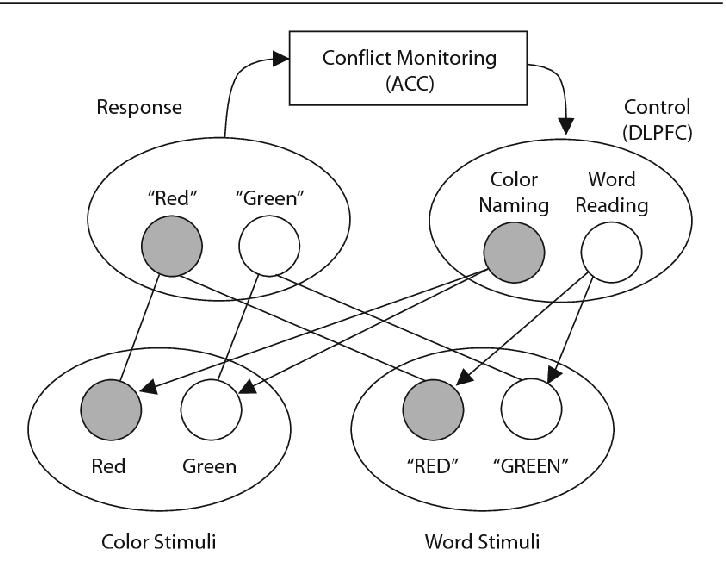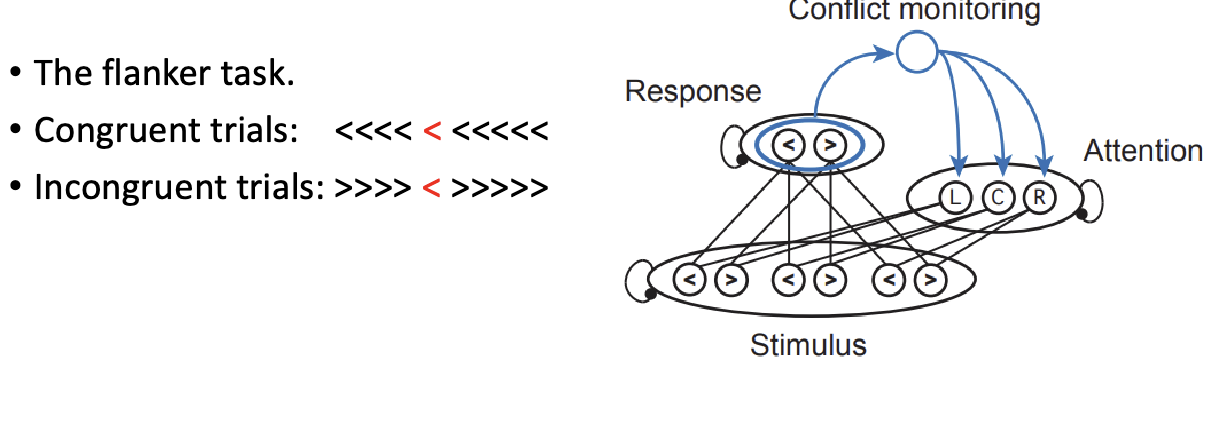Conflict and Error
1/15
There's no tags or description
Looks like no tags are added yet.
Name | Mastery | Learn | Test | Matching | Spaced |
|---|
No study sessions yet.
16 Terms
conflict monitoring model
built on the framework of “parallel distributed processing”
simulated neurons and interconnected neurons into computational units that had inputs and outputs
basically neural networks and the base for A.I
how to train a neural network to perform the Stroop task
stimuli (color or word) → response (red or green) → conflict monitoring in ACC (if the semantics and visual information don’t match up) → Control in DLPFC (encodes the rule (which one should be selected) → valid response

flanker task
similar to the Stroop task but with congruent and incongruent task
stare at the fixation point that has arrows flanking it

conflict monitoring unit
detect the need to enhance control and resolve conflic
control unit (task representation)
implements the control through top-down biasing
set up of fMRI to map conflict and control areas
separated the Stroop task into the instruction and response period
instruction: color or word
response: answer
the response period during the incongruent trials should engage the conflict monitoring unit
results of fMRI to map conflict and control areas
ACC: conflict
L. DLPFC: control
AxX-CPT Task
a task that increases error and response conflict
cue: a or B
delay period
probe: x or y
response
created a response mapping that is more automatic (A→x, and B→y)
other less frequent response mapping pairs will create more response competition (conflict and error)
results of AX-CPT task
the ACC activity increased for both error and response competition trials
ERN
error-related negativity
EEGs show a more negative signal when there’s an error
how negative the error is correlated to the reaction time (post-error slowing so you can be more attentive)
source of ERN
likely the medial PFC
what happens to error?
there might be an “error” module to detect errors, and then implement control. similar to conflict monitoring
monitoring and control of action by the frontal lobes
saccade version of the stop signal task
FEF: direct control of initiating or canceling a saccade
SEF: monitored actions, error neurons
monitoring system
ACC could act as a “monitor”: detecting situations when cognitive control is needed. suck as after an error, conflict, or competition between responses
ACC then actives task representation in the lateral PFC, which will then engage top-down control (through hierarchical organization)
EEG synchrony to map the interaction between ACC and lateral PFC
flanker task but with letters
goals:
characterize the pattern of neural synchrony between medial PFC and lateral PFC
could be the mechanism that allows the monitoring unit to communicate with the attention control unit
EEG synchrony results
error trials showed increased medial PFC activity
could reflect the engagement of the medial PFC monitoring unit
increase neural synchrony between medial PFC and lateral PFC for error trials
theta range
suggests that the monitoring unit is communicating with the attention control unit through theta synchrony